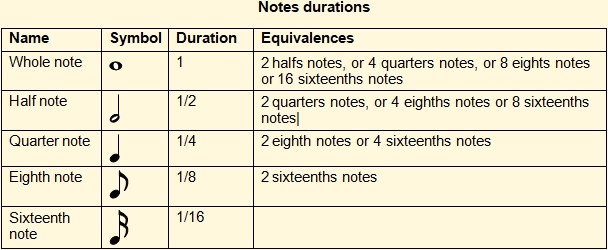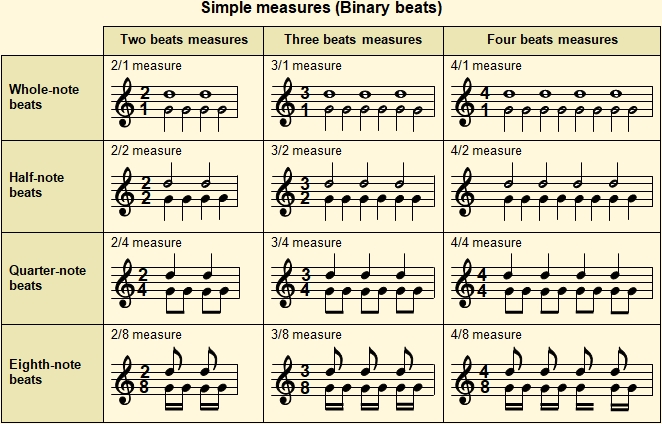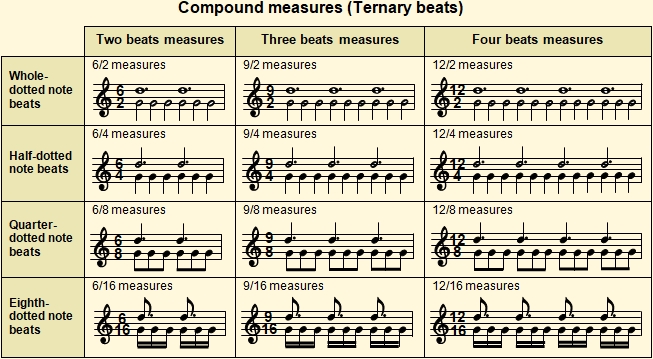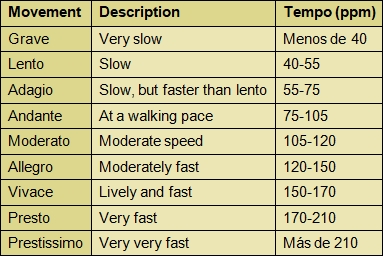
Time in music
Content
METRIC2/4 measures
4/4 measures
3/4 measures
Classifications of measures
Movement and tempo
RHYTHMIC
From the beginning of these pages we pointed out the importance of the organization in time in the development of a musical piece. In this chapter we will divide the study of this organization in time into the study of the metric, which implies regularity and repetition, and the rhythmic, which implies diversity and freedom within this regularity.
The organization of a piece in time is based on the adoption of a system that establishes fixed relationships between the durations of each of the notes. For example, on Home page we saw a simple arrangement of "Twinkle, Twinkle, Little Star" in which the length of the notes was represented by enclosing them in boxes of one or two units lengths. Next we repeat the first sentence of this arrangement:

Later the Standard musical notation allowed us to express these same durations in a more convenient way by means of a series of symbols for the durations of the notes. The two tables that follow are limited to show the durations of the notes and silences that we will use in these pages, but there are shorter durations: Thirty-second, Sixty-fourth,...


Now, we have several possibilities for representing the duration of the notes of "Twinkle, Twinkle, Little Star" in standard musical notation. For example, we could choose half notes to represent the unit duration and whole notes to represent the notes with duration of two units; however, the most common is to use quarters notes as a unit of time, so we will use these for the notes with duration of one unit and half notes for the notes with duration of two units; in this case we have:

METRIC
Although not always evident, every piece of music progresses in time following a uniform pattern of pulses equally spaced in time. A second level of temporal organization of a melody consists in the grouping of these pulses in measures of equal number of beats per compas, and consequently these measures contain notes and silences whose sum of durations is fixed. The first beats of each measure are strong beats, and the others are weak beats.
2/4 measures
"Twinkle, Twinkle, Little Star" has an implicit regular sequence of clearly discernible pulses that govern its progression in time:

The following recording contains the melody in conjunction with these pulses:
The diagram of the notes in the arrangement of "Twinkle, Twinkle, Little Star" suggests that they can be grouped in pairs. We can highlight the rhythm of this melody if we group every two pulses and accentuate the first of the pulses of each of these groups:

The following recording contains the melody in conjunction with accented pulses:
This accentuation produces such a powerful effect that if you listen to this recording several times and return to the previous, unaccented recording, your brain will probably continue to perceive this accentuation.
The above description, although elementary, illustrates the essence of the organization of music in measures. The standard notation dispenses with the graphic presentation of the marks indicating the pulses and the grouping of these pulses, and indicates the rhythmic scheme by means of two figures arranged in the form of a fraction, the time signature, immediately after the key signature, describing the metric used. The numerator of the fraction indicates the number of pulses per bar and the denominator the duration of the note corresponding to these pulses. It also uses dividing lines that cross the staff vertically and separate the groups of pulses that make up each measure. For the previous example the armature does not appear since the piece is in C major and does not contain alterations, the numerator of the fraction that indicates the rhythm is 2 since we have grouped the notes in pairs, and the denominator is 4 because the duration of each pulse is of quarter note, fourth part of a whole notes; therefore the score is as follows:

4/4 measures
The transcription of "Twinkle, Twinkle, Little Star" at a rhythm of 2/4 that we have just elaborated is correct; nevertheless most of the transcriptions of this piece use a rhythm of 4/4, the most used of all the rhythmic schemes. Below we show the pulse scheme that illustrates the pulses implicit in the phrase we are considering, and its accentuation in 4/4:

The score for this version is as follows:

The numerator of the time signatures has changed to 4 because now each compass (measure) groups four units of time (four quarter notes).
Note that between the two transcriptions of "Twinkle, Twinkle, Little Star" the only difference lies in the accentuation of the pulses. In both cases the pulse corresponding to the first time is accentuated, which corresponds to a strong time, the other pulses remain unaccented and are called weak times, but in the first transcription the accentuation occurs every two pulses, while in the second occurs every four pulses. As we will see in the following section, the ability to identify these strong tenses is fundamental to be able to discern the rhythmic scheme of a melody.
Not only are there more transcriptions of "Twinkle, Twinkle, Little Star" in the 4/4 rhythm, in reality this rhythmic scheme is the most widespread in Western music; however, there are other important schemes, such as the 3/4 rhythm that we will consider below.
3/4 measures
The "Amazing Grace" melody, the first one we consider in these pages, will not only serve to illustrate the 3/4 rhythm, but also other details related to the specification of the rhythm of any piece.
In the introduction to these pages we used the following diagram:to illustrate the first sentence of "Amazing Grace":

The arrangement of the notes in this diagram and the careful listening to this melody suggest that notes longer than one unit are accentuated. These notes are separated by three time units, which rules out the 2/4 and 4/4 rhythms already studied and suggests a grouping by groups of three pulses of unitary duration; however, there is only one time until the appearance of the first accented note, note C of "ma-", the second syllable. How then to group at the beginning of the transcription? The answer to the problem posed is to add two silences of unitary duration before the first note of the melody, so that there are also three beats in the first bar; this will then be an anachruse measure. Before going on to transcribe in definitive form this first phrase of the melody, let's verify the validity of our solution. If we choose quarter notes for the unit of time we will have:

We see that the use of an anachruse first measure produces a satisfactory arrangement. Below is the 3/4 rhythm used on the transcription of this phrase from "Amazing Grace":

Classification of measures
The number of beats in the 2/4 measures used in the first transcription for "Twinkle, Twinkle, Little Star" is two, so their measures are called binary, while in the 4/4 bars used in the second transcription it is four so their bars are called quaternary. On the other hand, the number of beats in the 3/4 measures used in the "Amazing Grace" transcription is three so they are called ternary measures. These types of measures, especially those of 4/4, are the most common, but other types of bars are used, most of which we will not use in these pages but it is convenient to consider in order to have a general idea of the different ways of organizing the measures.
The above examples illustrate the three unique forms used to divide the measures: into two, three and four beats, with accentuation of the first of these beats. Now, each of these beats can be subdivided in turn into several parts, the first of which is strong and the rest are weak.
Ordinary measures
In this section we will consider the compasses that exist by themselves, without making use of other measures in their conformation; these are the simple compasses and the compound measures. In the following section, dedicated to amalgam measures, we will consider the bars that are formed as combinations of ordinary measures.
Simple measures
When the times of a measure are divisible by two they are called binary times and give rise to simple measures. In these measures the sum of the values that make up each of their beats is equivalent to a sign of duration: a whole, a half, a quarter or an eighth note. Let's consider our two transcriptions of "Twinkle, Twinkle, Little Star": in both it is possible to express in a simple way the duration of each of the beats of the measure in terms of only one of the figures of duration, a quarter one in both 2/4 and 4/4 measures. We have the same situation in the case of "Amazing Grace": 3/4 measures were used, in which the duration of each time can be represented by a quarter note. Both melodies then have simple measures.
In simple measures the lower number of the time signature corresponds to the duration of a time; therefore, since each of the times of a simple measure corresponds to a whole, a half, a quarter or an eighth note, the lower number will assume only the values 1, 2, 4 and 8. Now, as all measures can only be divided into two, three or four beats, the upper number of the time signature will only assume the values 2, 3 and 4; there will be twelve types of simple bars, which we illustrate in the following table:

In the next section we will see that there are also twelve types of compound measures, and there are also amalgam measures; so familiarization with the different types of measures seems like hard work. However, there is no need to become familiar with all of them, since most music is composed using a few common types of measures; in the case of simple measures the most commonly used are the 4/4, 3/4 and 2/4 measures. It is also possible to rewrite some melodies that are written with other types of measures in terms of these common measures; as is the case of "Twinkle, Twinkle, Little Star" which we initially wrote with measures of two by four and later with measures of four by four. As we will see later, some melodies can be written with other types of measures and obtain identical results simply by adjusting the duration of the time unit.
Compound measures
When the times of a measure are divisible by three they are called ternary times and give rise to compound measures. In these measures, the sum of the values that make up each of their beats is equivalent to the duration of a sign of duration with dots: a whole-note with dots, a half-note with dots, a quarter-note with dots or an eighth-note with dots. Consider the following simple arrangement of a first sentence of the melody "Fur Elise":

Listen carefully to the recording of this arrangement:
Note that there are six pulses with eighth notes per measure, but these tend to be grouped in groups of three with accentuation of the first of the pulses of each of these groups. This arrangement is then made up of measures of two ternary beats, each with the duration of a dotted quarter note (three eighth notes); these are then measures made up of six eighth-notes.
Since, as for single measures, composite measures can only be divided into two, three, or four beats, but since each of these beats has a duration of one whole-dotted note, one half-dotted, one quarte-dotted note, or one eighth-dotted note, the top number of its time signature will assume only the values 6, 9, or 12. However, unlike simple measures in which the denominator of the time signature indicates the duration of half a time, the lower number of the time signature in the composite measures corresponds to the duration of one third of a time (the duration of the dot), so this numerator will assume the values of 2, 4, 8 and 16. The following table illustrates all the possibilities of composite measures:

The most common composite measures are the 6/8, 9/8 and 12/8 that appear in the third row. This is in close correspondence with what happens with the simple measures, for which the types of measures most used were also those of the third row of the table.
Mixed measures
Ordinary, simple and compound compasses are two, three and four-beat compasses. Mixed measures combine a binary or quaternary measure with another ternary to obtain measures with a greater number of beats; for example: five, seven and nine beats. Below we will see examples of some of these measures.
5/8 measures
The emphasis of the beats in the 5/8 measures can be set to 3 + 2 quarter-notes:

or as 3 + 2 quarter-notes:

7/8 measures
The emphasis of the beats in the 7/8 measures can be set to 4 + 3 eighth-notes:

or as 3 + 4 eighth-notes:

Movement and tempo
Movement or air is indicated by Italian terms that give a general idea of the slowness or speed at which a melody should be interpreted. The tempo is a more precise indication in terms of pulses per minute (ppm). There are a large number of terms for expressing movement; the most common ones are outlined below, with an approximate indication of the corresponding tempo range:

It is customary to indicate the movement and tempo at the beginning of the score in quarter-note pulses per minute. Sometimes only the movement or only the tempo is indicated. In the case of "Twinkle, Twinkle, Little Star" we have:


Note that although the measures are different in these two transcriptions, the tempo is the same because in both cases the tempo is fixed by quarter-notes.
When commenting on the table of simple measures we said that it is normally possible to transcribe melodies whose measures, also simple, are not the common ones of 2/4, 3/4 and 2/4. The following is an example that illustrates the type of considerations involved in these transcriptions. Suppose that the first score we find of "Twinkle, Twinkle, Little Star" is written with 2/2 measures:

RHYTMIC
In the previous sections we studied the metric, the regular organization in time of the measures of a piece of music; in the following sections we will study the rhythm, which allows to achieve variety within the regularity fixed by the metric by means of a location of notes that imply a displacement, division, omission, interruption or any other re arrangement of the regular pattern of pulses associated to the metric.
The pieces chosen to illustrate the metric concepts, "Twinkle, Twinkle, Little Star" for 2/4 and 4/4 measures, "Amazing Grace" fo follow the scheme set by the metric and in which the metric itself sets the rhythm. Below is a simple example of a piece that does not so rigidly follow the pulses of the metric and in which the rhythm can easily be felt in the melody itself, the next portion of a simple arrangement of the theme of "Swan Lake" in A minor:

However, the rhythm is usually accentuated by the use of chords and basses played by the instrument used for the melody itself or by other accompanying instruments. The rhythm can be indicated by notes drawn on additional ruled lines or indicated, as we will do in these pages, in a concise form at the beginning of the score:

When studying the accompaniment through the ukulele and the cuatro we will study numerous strumming schemes to establish the rhythm of a piece, but normally we will omit its express indication within the score.
Varios